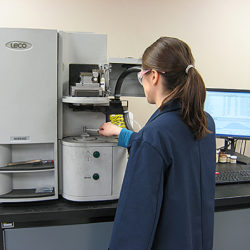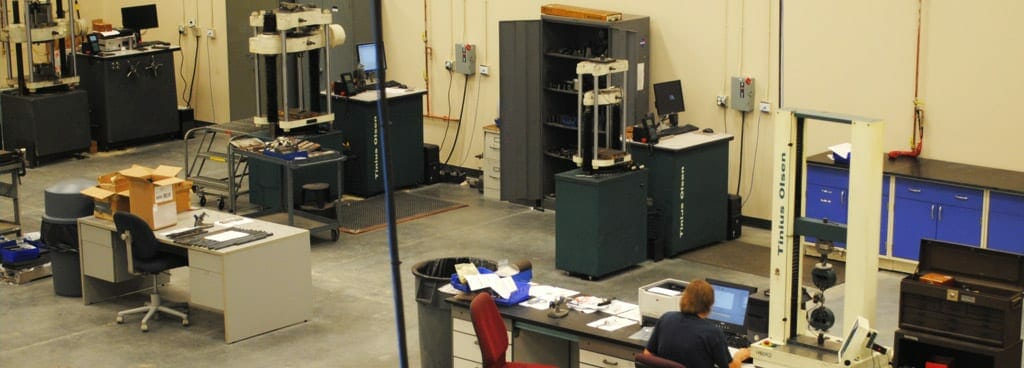Material Testing Lab Quality: Introducing the Keys to Project Sturdiness
Material Testing Lab Quality: Introducing the Keys to Project Sturdiness
Blog Article
Introducing the Tricks of Products: Technologies in Modern Product Testing
In the ever-evolving world of materials scientific research, researchers are frequently looking for methods to open the hidden keys of numerous substances. The mission to comprehend the residential or commercial properties, behavior, and prospective applications of products has actually caused impressive developments in modern-day material screening. From nanotechnology and expert system to non-destructive screening and high-throughput testing, new methods are arising that promise to transform our understanding of products. What are these developments? Exactly how do they function? And what can they disclose concerning the materials we come across daily? In this conversation, we will certainly untangle the enigmas behind these advanced technologies and explore exactly how they are reshaping the field of material scientific research.
Nanotechnology: Enhancing Product Checking Capabilities
Nanotechnology has reinvented material testing by enhancing its capabilities and permitting extraordinary precision and accuracy. With the ability to manipulate and manage materials at the nanoscale, engineers and scientists have had the ability to discover brand-new insights into the behavior and residential properties of various products. This has opened a whole new opportunity for material testing, allowing researchers to delve deeper right into the fundamental characteristics of products and explore their prospective applications.
One of the essential advantages of nanotechnology in product testing is its capacity to give extremely exact dimensions. By utilizing specialized nanoscale probes and sensors, researchers can obtain in-depth details about a product's mechanical, electric, and thermal homes. This degree of accuracy is crucial for sectors such as aerospace, vehicle, and electronic devices, where even the smallest inconsistency from desired specs can have considerable consequences.
Additionally, nanotechnology has enabled the growth of novel testing strategies that were previously unimaginable. Scanning probe microscopy methods, such as atomic force microscopy and scanning tunneling microscopy, make it possible for researchers to envision and manipulate materials at the atomic degree. This unprecedented level of control and monitoring has actually led the way for advancements in comprehending product actions and making innovative materials with tailored properties.
Expert System: Reinventing Material Analysis
The combination of expert system has actually brought about a revolution in material analysis, considerably enhancing the speed, accuracy, and efficiency of the process. With the ability to evaluate huge amounts of data in real-time, synthetic intelligence (AI) algorithms can quickly identify patterns, anomalies, and relationships that could or else go undetected by human analysts. This allows researchers and scientists to acquire a deeper understanding of products and their homes, resulting in the development of new and enhanced products for numerous applications.
AI-powered product evaluation likewise permits the forecast of product habits under different conditions, conserving substantial time and sources in the testing stage. By imitating numerous situations, AI algorithms can properly anticipate how products will certainly carry out in various settings, allowing designers to make enlightened decisions concerning their viability for specific applications.
Moreover, AI formulas can optimize product screening procedures by instantly changing parameters and experiment styles based on real-time feedback (material testing lab). This not just speeds up the screening procedure yet likewise ensures that the optimum amount of details is acquired from each experiment, leading to more trusted and extensive outcomes

Non-Destructive Screening: Exploring Materials From Within
Non-destructive testing strategies use a special way to discover the interior structure and properties of materials without causing any kind of damages or alteration. These strategies have revolutionized the area of material screening by allowing researchers and designers to analyze products from within, without endangering their integrity. Non-destructive screening methods use various modern technologies and methods to analyze products and supply valuable understandings right into their structure, issues, and performance.
One extensively used non-destructive testing strategy is ultrasonic testing, which involves sending out high-frequency acoustic waves with a product and examining the mirrored waves to determine its inner structure. This technique is commonly utilized to identify flaws, such as fractures or gaps, in steels, composites, and concrete. One more strategy, called X-ray radiography, utilizes X-rays to develop pictures of the interior attributes of a product, making it particularly beneficial for examining welds and spotting surprise problems.
Other non-destructive testing approaches consist of magnetic anonymous particle screening, which uses electromagnetic fields to identify surface area and near-surface issues in ferromagnetic products, and swirl present screening, which utilizes electromagnetic induction to identify flaws in conductive materials. These techniques, together with others like thermography and visual assessment, give beneficial information about the architectural honesty and top quality of products, guaranteeing their integrity and safety and security in numerous applications.
Non-destructive screening is specifically critical in sectors such as aerospace, auto, power, and construction, where the performance and reliability of materials are of utmost importance. By enabling comprehensive product evaluation without creating damages or modification, non-destructive testing techniques play a vital role in ensuring the top quality and durability of products in a vast array of applications.
High-Throughput Screening: Accelerating Product Exploration
High-throughput screening strategies have actually reinvented the process of material exploration by speeding up the identification and analysis of brand-new materials. This strategy enables researchers to swiftly screen a a great deal of materials, making it possible for the identification of promising prospects for additional examination.
High-throughput testing involves making use of automated robotics and systems to carry out experiments on a huge scale (material testing lab). This allows researchers to swiftly evaluate a Extra resources vast array of products under different problems, such as make-up, temperature level, and stress. By evaluating the resulting information, researchers can determine materials with preferred properties, such as high strength, conductivity, or thermal stability
One of the key benefits of high-throughput screening is its ability to accelerate the exploration of new materials with enhanced residential or commercial properties. Standard methods of material discovery usually entail trial and mistake, which can be time-consuming and inefficient. With high-throughput testing, researchers can systematically explore a huge selection of products in a fraction of the time, dramatically accelerating the discovery process.
Furthermore, high-throughput testing can additionally supply useful understandings into the underlying structure-property connections of products. By examining a lot of materials with varying make-ups and structures, researchers can better understand how different factors influence material homes. This understanding can after that be utilized to create and enhance products with particular residential properties for numerous applications, such as power storage, electronics, and healthcare.
Advanced Simulation Techniques: Forecasting Material Performance
Advanced simulation strategies play a crucial role in forecasting the efficiency of materials in various applications. These techniques entail using computer models and mathematical formulas to imitate the habits of materials under various problems. By mimicing the behavior of products at the molecular and atomic degree, researchers can gain useful understandings into their mechanical, thermal, and chemical residential or commercial properties.
Among the crucial advantages of innovative simulation methods is their ability to forecast material performance prior to physical testing. This not just saves time and sources however also permits researchers to discover a broader series of products and design parameters. In the field of products design, simulations can aid determine the optimal structure and framework of a material to accomplish specific buildings.

Along with predicting material performance, these simulation strategies also aid in recognizing the hidden mechanisms that control material actions. By evaluating the simulation results, researchers can acquire insights into the essential principles that determine the residential or commercial properties and efficiency of materials.
Final Thought
Finally, the developments in material screening strategies have actually significantly improved our understanding and evaluation of numerous materials. Nanotechnology has permitted enhanced abilities in screening and adjusting products at the nanoscale. Expert system has revolutionized material analysis by offering much faster and extra accurate results. Non-destructive testing has enabled us to explore the internal homes of materials without creating damages. High-throughput testing has actually accelerated the exploration of brand-new products. Advanced simulation strategies have actually played a critical duty in forecasting product performance. These developments remain to open the secrets of products and drive additional innovations in numerous markets.
The mission to understand the buildings, habits, and prospective applications of products has actually led to amazing technologies in contemporary material screening. These techniques have actually transformed the area of product testing by making it possible for researchers and engineers to take a look at materials from within, without jeopardizing their integrity. By checking a big number of products with varying structures and make-ups, researchers can much better understand exactly how various elements affect material properties. Full Article In the field of products design, simulations can assist recognize the optimal make-up and framework of a material to attain specific buildings.
In conclusion, the innovations in material testing methods have actually significantly improved our understanding and evaluation of various products.
Report this page